Deck 9: Rotational Motion
سؤال
سؤال
سؤال
سؤال
سؤال
سؤال
سؤال
سؤال
سؤال
سؤال
سؤال
سؤال
سؤال
سؤال
سؤال
سؤال
سؤال
سؤال
سؤال
سؤال
سؤال
سؤال
سؤال
سؤال
سؤال
سؤال
سؤال
سؤال
سؤال
سؤال
سؤال
سؤال
سؤال
سؤال
سؤال
سؤال
سؤال
سؤال
سؤال
سؤال
سؤال
سؤال
سؤال
سؤال
سؤال
سؤال
سؤال

فتح الحزمة
قم بالتسجيل لفتح البطاقات في هذه المجموعة!
Unlock Deck
Unlock Deck
1/47
العب
ملء الشاشة (f)
Deck 9: Rotational Motion
1
The disk in a DVD player has an angular velocity of 8.0 rad/s when it is turned off. The disk comes to rest 2.5 s after being turned off. Through how many radians does the disk rotate after being turned off? Assume constant angular acceleration.
A)12 rad
B)8.0 rad
C)10 rad
D)16 rad
E)6.8 rad
A)12 rad
B)8.0 rad
C)10 rad
D)16 rad
E)6.8 rad
10 rad
2
Three particles, each of which has a mass of 80 g, are positioned at the vertices of an equilateral triangle with sides of length 60 cm. The particles are connected by rods of negligible mass. What is the moment of inertia of this rigid body about an axis that is parallel to one side of the triangle and passes through the respective midpoints of the other two sides?
A)0.018 kg.m2
B)0.020 kg.m2
C)0.016 kg.m2
D)0.022 kg.m2
E)0.032 kg.m2
A)0.018 kg.m2
B)0.020 kg.m2
C)0.016 kg.m2
D)0.022 kg.m2
E)0.032 kg.m2
0.016 kg.m2
3
A wheel starts from rest and rotates with a constant angular acceleration about a fixed axis. It completes the first revolution 6.0 s after it started. How long after it started will the wheel complete the second revolution?
A)9.9 s
B)7.8 s
C)8.5 s
D)9.2 s
E)6.4 s
A)9.9 s
B)7.8 s
C)8.5 s
D)9.2 s
E)6.4 s
8.5 s
4
A thin uniform rod (length = 1.2 m, mass = 2.0 kg) is pivoted about a horizontal, frictionless pin through one end of the rod. (The moment of inertia of the rod about this axis is ML2/3.) The rod is released when it makes an angle of 37 with the horizontal. What is the angular acceleration of the rod at the instant it is released?
A)9.8 rad/s2
B)7.4 rad/s2
C)8.4 rad/s2
D)5.9 rad/s2
E)6.5 rad/s2
A)9.8 rad/s2
B)7.4 rad/s2
C)8.4 rad/s2
D)5.9 rad/s2
E)6.5 rad/s2

فتح الحزمة
افتح القفل للوصول البطاقات البالغ عددها 47 في هذه المجموعة.
فتح الحزمة
k this deck
5
A wheel (radius = 0.20 m) starts from rest and rotates with a constant angular acceleration of 2.0 rad/s2. At the instant when the angular velocity is equal to 1.2 rad/s, what is the magnitude of the total linear acceleration of a point on the rim of the wheel?
A)0.40 m/s2
B)0.29 m/s2
C)0.69 m/s2
D)0.49 m/s2
E)0.35 m/s2
A)0.40 m/s2
B)0.29 m/s2
C)0.69 m/s2
D)0.49 m/s2
E)0.35 m/s2

فتح الحزمة
افتح القفل للوصول البطاقات البالغ عددها 47 في هذه المجموعة.
فتح الحزمة
k this deck
6
Two vectors lying in the xz plane are given by the equations  and
and  . The value of
. The value of  is:
is:
A)
B)
C)7
D)(-7 )
)
E)
 and
and  . The value of
. The value of  is:
is:A)

B)

C)7

D)(-7
 )
)E)


فتح الحزمة
افتح القفل للوصول البطاقات البالغ عددها 47 في هذه المجموعة.
فتح الحزمة
k this deck
7
A wheel rotates about a fixed axis with an initial angular velocity of 20 rad/s. During a 5.0-s interval the angular velocity increases to 40 rad/s. Assume that the angular acceleration was constant during the 5.0-s interval. How many revolutions does the wheel turn through during the 5.0-s interval?
A)20 rev
B)24 rev
C)32 rev
D)28 rev
E)39 rev
A)20 rev
B)24 rev
C)32 rev
D)28 rev
E)39 rev

فتح الحزمة
افتح القفل للوصول البطاقات البالغ عددها 47 في هذه المجموعة.
فتح الحزمة
k this deck
8
Two vectors lying in the xy plane are given by the equations  and
and  . The value of
. The value of  is:
is:
A)19
B)(-11 )
)
C)(-19 )
)
D)11
E)10
 and
and  . The value of
. The value of  is:
is:A)19

B)(-11
 )
)C)(-19
 )
)D)11

E)10


فتح الحزمة
افتح القفل للوصول البطاقات البالغ عددها 47 في هذه المجموعة.
فتح الحزمة
k this deck
9
Four identical particles (mass of each = 0.24 kg) are placed at the vertices of a rectangle (2.0 m * 3.0 m) and held in those positions by four light rods, which form the sides of the rectangle. What is the moment of inertia of this rigid body about an axis that passes through the centre of mass of the body and is parallel to the shorter sides of the rectangle?
A)2.4 kg.m2
B)2.2 kg.m2
C)1.9 kg.m2
D)2.7 kg.m2
E)8.6 kg.m2
A)2.4 kg.m2
B)2.2 kg.m2
C)1.9 kg.m2
D)2.7 kg.m2
E)8.6 kg.m2

فتح الحزمة
افتح القفل للوصول البطاقات البالغ عددها 47 في هذه المجموعة.
فتح الحزمة
k this deck
10
A wheel (radius = 12 cm) is mounted on a frictionless, horizontal axle that is perpendicular to the wheel and passes through the centre of mass of the wheel. A light cord wrapped around the wheel supports a 0.40-kg object. If released from rest with the string taut, the object is observed to fall with a downward acceleration of 3.0 m/s2. What is the moment of inertia (of the wheel) about the given axle?
A)0.023 kg.m2
B)0.013 kg.m2
C)0.020 kg.m2
D)0.016 kg.m2
E)0.035 kg.m2
A)0.023 kg.m2
B)0.013 kg.m2
C)0.020 kg.m2
D)0.016 kg.m2
E)0.035 kg.m2

فتح الحزمة
افتح القفل للوصول البطاقات البالغ عددها 47 في هذه المجموعة.
فتح الحزمة
k this deck
11
A wheel rotating about a fixed axis with a constant angular acceleration of 2.0 rad/s2 turns through 2.4 revolutions during a 2.0-s time interval. What is the angular velocity at the end of this time interval?
A)9.5 rad/s
B)9.7 rad/s
C)9.3 rad/s
D)9.1 rad/s
E)8.8 rad/s
A)9.5 rad/s
B)9.7 rad/s
C)9.3 rad/s
D)9.1 rad/s
E)8.8 rad/s

فتح الحزمة
افتح القفل للوصول البطاقات البالغ عددها 47 في هذه المجموعة.
فتح الحزمة
k this deck
12
A wheel rotates about a fixed axis with a constant angular acceleration of 4.0 rad/s2. The diameter of the wheel is 40 cm. What is the linear speed of a point on the rim of this wheel at an instant when that point has a total linear acceleration with a magnitude of 1.2 m/s2?
A)39 cm/s
B)42 cm/s
C)45 cm/s
D)35 cm/s
E)53 cm/s
A)39 cm/s
B)42 cm/s
C)45 cm/s
D)35 cm/s
E)53 cm/s

فتح الحزمة
افتح القفل للوصول البطاقات البالغ عددها 47 في هذه المجموعة.
فتح الحزمة
k this deck
13
A particle located at the position vector  m has a force
m has a force  N acting on it. The torque about the origin is:
N acting on it. The torque about the origin is:
A)(1 )N.m
)N.m
B)(5 )N.m
)N.m
C)(-1 )N.m
)N.m
D)(-5 )N.m
)N.m
E)(2 + 3
+ 3
 )N.m
)N.m
 m has a force
m has a force  N acting on it. The torque about the origin is:
N acting on it. The torque about the origin is:A)(1
 )N.m
)N.mB)(5
 )N.m
)N.mC)(-1
 )N.m
)N.mD)(-5
 )N.m
)N.mE)(2
 + 3
+ 3 )N.m
)N.m
فتح الحزمة
افتح القفل للوصول البطاقات البالغ عددها 47 في هذه المجموعة.
فتح الحزمة
k this deck
14
A mass m = 4.0 kg is connected, as shown, by a light cord to a mass M = 6.0 kg, which slides on a smooth horizontal surface. The pulley rotates about a frictionless axle and has a radius R = 0.12 m and a moment of inertia I = 0.090 kg.m2. The cord does not slip on the pulley. What is the magnitude of the acceleration of m? 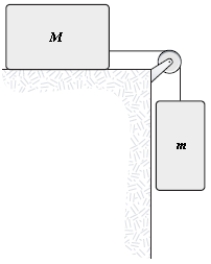
A)2.4 m/s2
B)2.8 m/s2
C)3.2 m/s2
D)4.2 m/s2
E)1.7 m/s2

A)2.4 m/s2
B)2.8 m/s2
C)3.2 m/s2
D)4.2 m/s2
E)1.7 m/s2

فتح الحزمة
افتح القفل للوصول البطاقات البالغ عددها 47 في هذه المجموعة.
فتح الحزمة
k this deck
15
A wheel (radius = 0.20 m) is mounted on a frictionless, horizontal axis. A light cord wrapped around the wheel supports a 0.50-kg object, as shown in the figure. When released from rest the object falls with a downward acceleration of 5.0 m/s2. What is the moment of inertia of the wheel? 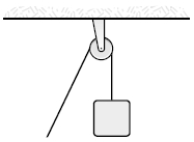
A)0.023 kg.m2
B)0.027 kg.m2
C)0.016 kg.m2
D)0.019 kg.m2
E)0.032 kg.m2

A)0.023 kg.m2
B)0.027 kg.m2
C)0.016 kg.m2
D)0.019 kg.m2
E)0.032 kg.m2

فتح الحزمة
افتح القفل للوصول البطاقات البالغ عددها 47 في هذه المجموعة.
فتح الحزمة
k this deck
16
Two particles (m1 = 0.20 kg, m2 = 0.30 kg) are positioned at the ends of a 2.0-m long rod of negligible mass. What is the moment of inertia of this rigid body about an axis perpendicular to the rod and through the centre of mass?
A)0.48 kg.m2
B)0.50 kg.m2
C)1.2 kg.m2
D)0.80 kg.m2
E)0.70 kg.m2
A)0.48 kg.m2
B)0.50 kg.m2
C)1.2 kg.m2
D)0.80 kg.m2
E)0.70 kg.m2

فتح الحزمة
افتح القفل للوصول البطاقات البالغ عددها 47 في هذه المجموعة.
فتح الحزمة
k this deck
17
A wheel rotating about a fixed axis has a constant angular acceleration of 4.0 rad/s2. In a 4.0-s interval the wheel turns through an angle of 80 radians. Assuming the wheel started from rest, how long had it been in motion at the start of the 4.0-s interval?
A)2.5 s
B)4.0 s
C)3.5 s
D)3.0 s
E)4.5 s
A)2.5 s
B)4.0 s
C)3.5 s
D)3.0 s
E)4.5 s

فتح الحزمة
افتح القفل للوصول البطاقات البالغ عددها 47 في هذه المجموعة.
فتح الحزمة
k this deck
18
If M = 0.50 kg, L = 1.2 m, and the mass of each connecting rod shown is negligible, what is the moment of inertia about an axis perpendicular to the paper through the centre of mass? Treat the mass as particles. 
A)3.7 kg.m2
B)2.8 kg.m2
C)3.2 kg.m2
D)2.3 kg.m2
E)3.9 kg.m2

A)3.7 kg.m2
B)2.8 kg.m2
C)3.2 kg.m2
D)2.3 kg.m2
E)3.9 kg.m2

فتح الحزمة
افتح القفل للوصول البطاقات البالغ عددها 47 في هذه المجموعة.
فتح الحزمة
k this deck
19
Particles (mass of each = 0.20 kg) are placed at the 40-cm and 100-cm marks of a metre stick of negligible mass. This rigid body is free to rotate about a frictionless pivot at the 0-cm end. The body is released from rest in the horizontal position. What is the initial angular acceleration of the body?
A)12 rad/s2
B)5.9 rad/s2
C)8.4 rad/s2
D)5.4 rad/s2
E)17 rad/s2
A)12 rad/s2
B)5.9 rad/s2
C)8.4 rad/s2
D)5.4 rad/s2
E)17 rad/s2

فتح الحزمة
افتح القفل للوصول البطاقات البالغ عددها 47 في هذه المجموعة.
فتح الحزمة
k this deck
20
A uniform rod (mass = 2.0 kg, length = 0.60 m) is free to rotate about a frictionless pivot at one end. The rod is released from rest in the horizontal position. What is the magnitude of the angular acceleration of the rod at the instant it is 60 below the horizontal?
A)15 rad/s2
B)12 rad/s2
C)18 rad/s2
D)29 rad/s2
E)23 rad/s2
A)15 rad/s2
B)12 rad/s2
C)18 rad/s2
D)29 rad/s2
E)23 rad/s2

فتح الحزمة
افتح القفل للوصول البطاقات البالغ عددها 47 في هذه المجموعة.
فتح الحزمة
k this deck
21
The figure below shows a graph of angular velocity as a function of time for a car driving around a circular track. Through how many radians does the car travel in the first 10 minutes? 
A)30
B)50
C)70
D)90
E)100

A)30
B)50
C)70
D)90
E)100

فتح الحزمة
افتح القفل للوصول البطاقات البالغ عددها 47 في هذه المجموعة.
فتح الحزمة
k this deck
22
Refer to Exhibit 9-2 below.Exhibit 9-2 The figure below shows a graph of angular velocity versus time for a man cycling around a circular track. 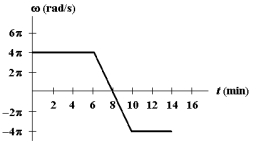 What is his average angular acceleration, in rad/s2, in the period from t = 6 min to t = 8 min?
What is his average angular acceleration, in rad/s2, in the period from t = 6 min to t = 8 min?
A)0
B)
C)
D)
E)
 What is his average angular acceleration, in rad/s2, in the period from t = 6 min to t = 8 min?
What is his average angular acceleration, in rad/s2, in the period from t = 6 min to t = 8 min?A)0
B)
C)
D)
E)

فتح الحزمة
افتح القفل للوصول البطاقات البالغ عددها 47 في هذه المجموعة.
فتح الحزمة
k this deck
23
Exhibit 9-1 The figure below shows a graph of angular velocity versus time for a woman cycling around a circular track. 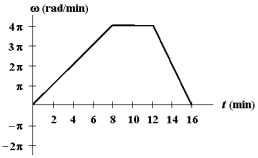 What is her angular displacement (in rad) in the first 8 minutes?
What is her angular displacement (in rad) in the first 8 minutes?
A)0
B)( )
C)4
D)8
E)16
 What is her angular displacement (in rad) in the first 8 minutes?
What is her angular displacement (in rad) in the first 8 minutes?A)0
B)( )
C)4
D)8
E)16

فتح الحزمة
افتح القفل للوصول البطاقات البالغ عددها 47 في هذه المجموعة.
فتح الحزمة
k this deck
24
Refer to Exhibit 9-2 below.Exhibit 9-2 The figure below shows a graph of angular velocity versus time for a man cycling around a circular track.  What is his average angular acceleration, in rad/s2, in the first 10 minutes?
What is his average angular acceleration, in rad/s2, in the first 10 minutes?
A)0
B)
C)
D)
E)
 What is his average angular acceleration, in rad/s2, in the first 10 minutes?
What is his average angular acceleration, in rad/s2, in the first 10 minutes?A)0
B)
C)
D)
E)

فتح الحزمة
افتح القفل للوصول البطاقات البالغ عددها 47 في هذه المجموعة.
فتح الحزمة
k this deck
25
A uniform cylinder of radius R, mass M, and length L rotates freely about a horizontal axis parallel and tangent to the cylinder, as shown below. The moment of inertia of the cylinder about this axis is 
A) .
B) .
C)MR2.
D) .
E) .

A) .
B) .
C)MR2.
D) .
E) .

فتح الحزمة
افتح القفل للوصول البطاقات البالغ عددها 47 في هذه المجموعة.
فتح الحزمة
k this deck
26
Two people are on a ride where the inside cars rotate at constant angular velocity three times the constant angular velocity of the outer cars. If the two cars are in line at t = 0, and moving at 3 and respectively, at what time will they next pass each other?
A)t = 0.
B)t = .
.
C)t = .
.
D)t = .
.
E)t = .
.
A)t = 0.
B)t =
 .
.C)t =
 .
.D)t =
 .
.E)t =
 .
.
فتح الحزمة
افتح القفل للوصول البطاقات البالغ عددها 47 في هذه المجموعة.
فتح الحزمة
k this deck
27
Imagine that you are at Luna Park having a ride on a carousel. As you go round and round, you look up and see that a seagull is flying in a circle directly over your head. As you go around in a circle, so does the seagull, so that it remains directly over you. Naturally you are a bit freaked out by this, and you start to wonder if the seagull has taken a dislike to you, and plans to do a dropping on your head. Will a dropping the bird releases while flying directly above your head hit you?
A)Yes, because it falls straight down.
B)Yes, because it maintains the acceleration of the bird as it falls.
C)No, because it falls straight down and will land behind the person.
D)Yes, because it maintains the angular velocity of the bird as it falls.
E)No, because it maintains the tangential velocity the bird had at the instant it started falling.
A)Yes, because it falls straight down.
B)Yes, because it maintains the acceleration of the bird as it falls.
C)No, because it falls straight down and will land behind the person.
D)Yes, because it maintains the angular velocity of the bird as it falls.
E)No, because it maintains the tangential velocity the bird had at the instant it started falling.

فتح الحزمة
افتح القفل للوصول البطاقات البالغ عددها 47 في هذه المجموعة.
فتح الحزمة
k this deck
28
The angular speed of the hour hand of a clock, in rad/s, is:
A) .
B) .
C) .
D)1 800 .
E)7 200 .
A) .
B) .
C) .
D)1 800 .
E)7 200 .

فتح الحزمة
افتح القفل للوصول البطاقات البالغ عددها 47 في هذه المجموعة.
فتح الحزمة
k this deck
29
Refer to Exhibit 9-1 below.Exhibit 9-1 The figure below shows a graph of angular velocity versus time for a woman cycling around a circular track.  What is her angular displacement (in rad) in the first 12 minutes?
What is her angular displacement (in rad) in the first 12 minutes?
A)0
B)2
C)4
D)16
E)32
 What is her angular displacement (in rad) in the first 12 minutes?
What is her angular displacement (in rad) in the first 12 minutes?A)0
B)2
C)4
D)16
E)32

فتح الحزمة
افتح القفل للوصول البطاقات البالغ عددها 47 في هذه المجموعة.
فتح الحزمة
k this deck
30
Refer to Exhibit 9-1 below.Exhibit 9-1 The figure below shows a graph of angular velocity versus time for a woman cycling around a circular track. 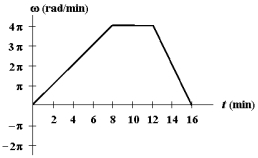 How many revolutions does she complete in the first 12 minutes?
How many revolutions does she complete in the first 12 minutes?
A)4
B)8
C)12
D)16
E)32
 How many revolutions does she complete in the first 12 minutes?
How many revolutions does she complete in the first 12 minutes?A)4
B)8
C)12
D)16
E)32

فتح الحزمة
افتح القفل للوصول البطاقات البالغ عددها 47 في هذه المجموعة.
فتح الحزمة
k this deck
31
A uniform rod of mass M = 1.2 kg and length L = 0.80 m, lying on a frictionless horizontal plane, is free to pivot about a vertical axis through one end, as shown. The moment of inertia of the rod about this axis is given by (1/3)ML2. If a force (F = 5.0 N, = 40 ) acts as shown, what is the resulting angular acceleration about the pivot point? 
A)16 rad/s2
B)12 rad/s2
C)14 rad/s2
D)10 rad/s2
E)33 rad/s2

A)16 rad/s2
B)12 rad/s2
C)14 rad/s2
D)10 rad/s2
E)33 rad/s2

فتح الحزمة
افتح القفل للوصول البطاقات البالغ عددها 47 في هذه المجموعة.
فتح الحزمة
k this deck
32
The graphs below show angular velocity as a function of time. In which one is the magnitude of the angular acceleration constantly decreasing?
A)
B)
C)
D)
E)
A)

B)

C)

D)

E)


فتح الحزمة
افتح القفل للوصول البطاقات البالغ عددها 47 في هذه المجموعة.
فتح الحزمة
k this deck
33
Refer to Exhibit 9-1 below.Exhibit 9-1 The figure below shows a graph of angular velocity versus time for a woman cycling around a circular track. 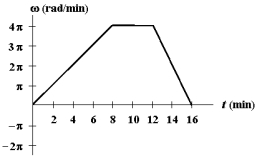 What is her angular displacement (in rad) in the 16-minute period shown in the graph?
What is her angular displacement (in rad) in the 16-minute period shown in the graph?
A)0
B)16
C)32
D)40
E)64
 What is her angular displacement (in rad) in the 16-minute period shown in the graph?
What is her angular displacement (in rad) in the 16-minute period shown in the graph?A)0
B)16
C)32
D)40
E)64

فتح الحزمة
افتح القفل للوصول البطاقات البالغ عددها 47 في هذه المجموعة.
فتح الحزمة
k this deck
34
The graph below shows a plot of angular acceleration in rad/s2 versus time from t = 0 s to t = 8 s. The change in angular velocity, , during this 8-second period is: 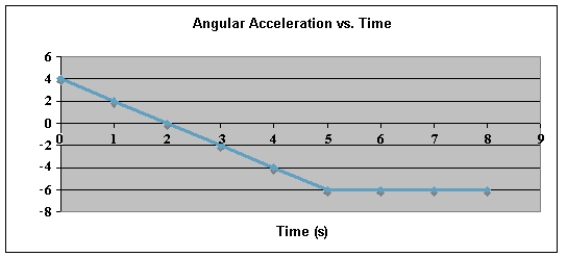
A) , CW.
B) , CCW.
C) , CW.
D) , CCW.
E) , CW.

A) , CW.
B) , CCW.
C) , CW.
D) , CCW.
E) , CW.

فتح الحزمة
افتح القفل للوصول البطاقات البالغ عددها 47 في هذه المجموعة.
فتح الحزمة
k this deck
35
A small sphere attached to a light rigid rod rotates about an axis perpendicular to and fixed to the other end of the rod. Relative to the positive direction of the axis of rotation, the angular positions of the sphere are positive, its angular velocity is positive, and its angular acceleration is negative. The sphere is:
A)rotating clockwise and slowing down.
B)rotating counterclockwise and slowing down.
C)rotating clockwise and speeding up.
D)rotating counterclockwise and speeding up.
E)first rotating clockwise and then counterclockwise.
A)rotating clockwise and slowing down.
B)rotating counterclockwise and slowing down.
C)rotating clockwise and speeding up.
D)rotating counterclockwise and speeding up.
E)first rotating clockwise and then counterclockwise.

فتح الحزمة
افتح القفل للوصول البطاقات البالغ عددها 47 في هذه المجموعة.
فتح الحزمة
k this deck
36
Which of the following diagrams shows the greatest magnitude net torque with a zero net force? All the rods, of length 2r, rotate about an axis that is perpendicular to the rod and fixed in the centre of the rod. All the forces are of magnitude F or 2F and all distances from the axis are r or r/2.
A)
B)
C)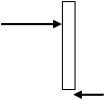
D)
E)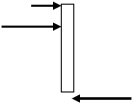
A)

B)

C)

D)

E)


فتح الحزمة
افتح القفل للوصول البطاقات البالغ عددها 47 في هذه المجموعة.
فتح الحزمة
k this deck
37
A uniform sphere of radius R and mass M rotates freely about a horizontal axis that is tangent to an equatorial plane of the sphere, as shown below. The moment of inertia of the sphere about this axis is: 
A) .
B) .
C) .
D) .
E) .

A) .
B) .
C) .
D) .
E) .

فتح الحزمة
افتح القفل للوصول البطاقات البالغ عددها 47 في هذه المجموعة.
فتح الحزمة
k this deck
38
A uniform metre stick is pivoted to rotate about a horizontal axis through the 25-cm mark on the stick. The stick is released from rest in a horizontal position. The moment of inertia of a uniform rod about an axis perpendicular to the rod and through the centre of mass of the rod is given by (1/12)ML2. Determine the magnitude of the initial angular acceleration of the stick.
A)17 rad/s2
B)13 rad/s2
C)15 rad/s2
D)19 rad/s2
E)23 rad/s2
A)17 rad/s2
B)13 rad/s2
C)15 rad/s2
D)19 rad/s2
E)23 rad/s2

فتح الحزمة
افتح القفل للوصول البطاقات البالغ عددها 47 في هذه المجموعة.
فتح الحزمة
k this deck
39
Refer to Exhibit 9-1 below.Exhibit 9-1 The figure below shows a graph of angular velocity versus time for a woman cycling around a circular track. 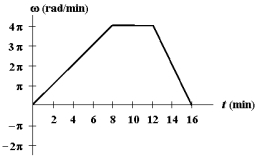 How many revolutions does she complete in the 16-minute period?
How many revolutions does she complete in the 16-minute period?
A)8
B)12
C)16
D)20
E)40
 How many revolutions does she complete in the 16-minute period?
How many revolutions does she complete in the 16-minute period?A)8
B)12
C)16
D)20
E)40

فتح الحزمة
افتح القفل للوصول البطاقات البالغ عددها 47 في هذه المجموعة.
فتح الحزمة
k this deck
40
A uniform rod is 2.0 m long. The rod is pivoted about a horizontal, frictionless pin through one end. The rod is released from rest at the horizontal position. What is the angular acceleration of the rod at the instant the rod makes an angle of 70 with the horizontal?
A)3.7 rad/s2
B)1.3 rad/s2
C)2.5 rad/s2
D)4.9 rad/s2
E)1.9 rad/s2
A)3.7 rad/s2
B)1.3 rad/s2
C)2.5 rad/s2
D)4.9 rad/s2
E)1.9 rad/s2

فتح الحزمة
افتح القفل للوصول البطاقات البالغ عددها 47 في هذه المجموعة.
فتح الحزمة
k this deck
41
A celestial object called a pulsar emits its light in short bursts that are synchronised with its rotation. A pulsar in the Crab Nebula is rotating at a rate of 30 revolutions/second. What is the maximum radius of the pulsar, if no part of its surface can move faster than the speed of light (3 *108 m/s)?

فتح الحزمة
افتح القفل للوصول البطاقات البالغ عددها 47 في هذه المجموعة.
فتح الحزمة
k this deck
42
When a wheel is rolling without slipping, the magnitude of its velocity relative to the ground is greatest at:
A)the point in contact with the ground.
B)the point at the centre of the wheel.
C)the point at the top of the wheel opposite to the point in contact with the ground.
D)the point farthest forward from the centre of mass of the wheel.
E)the point farthest behind the centre of mass of the wheel.
A)the point in contact with the ground.
B)the point at the centre of the wheel.
C)the point at the top of the wheel opposite to the point in contact with the ground.
D)the point farthest forward from the centre of mass of the wheel.
E)the point farthest behind the centre of mass of the wheel.

فتح الحزمة
افتح القفل للوصول البطاقات البالغ عددها 47 في هذه المجموعة.
فتح الحزمة
k this deck
43
The graph below shows a plot of angular acceleration in rad/s2 versus time from t = 0 s to t = 8 s. The angular velocity at t = 0 s is , CCW. The angular velocity, , at t = 8 s is: 
A) , CW.
B) , CCW.
C) , CW.
D) , CCW.
E) , CW.

A) , CW.
B) , CCW.
C) , CW.
D) , CCW.
E) , CW.

فتح الحزمة
افتح القفل للوصول البطاقات البالغ عددها 47 في هذه المجموعة.
فتح الحزمة
k this deck
44
A rod of length 1.00 m has a mass per unit length given by , where is in kg/m. The rod is placed on the x axis going from x = 0.00 m to x = 1.00 m. What is the moment of inertia of the rod in kg m2 about the y axis?

فتح الحزمة
افتح القفل للوصول البطاقات البالغ عددها 47 في هذه المجموعة.
فتح الحزمة
k this deck
45
A horizontal force of magnitude 6.5 N is exerted tangentially on a Frisbee of mass 32 grams and radius 14.3 cm. Assuming the Frisbee, a uniform disk, is originally at rest and the force is exerted for 0.08 s, determine the angular velocity of rotation about the central axis when the Frisbee is released.

فتح الحزمة
افتح القفل للوصول البطاقات البالغ عددها 47 في هذه المجموعة.
فتح الحزمة
k this deck
46
When the sum of the external forces and the sum of the external torques on a body are both zero, we can conclude that:
A)the body is moving at constant velocity but is not rotating.
B)the body is rotating at constant angular velocity but has no linear velocity.
C)the body has neither linear nor angular velocity.
D)the body may have constant linear or angular velocity, but not both simultaneously.
E)the body will have constant linear and constant angular velocity.
A)the body is moving at constant velocity but is not rotating.
B)the body is rotating at constant angular velocity but has no linear velocity.
C)the body has neither linear nor angular velocity.
D)the body may have constant linear or angular velocity, but not both simultaneously.
E)the body will have constant linear and constant angular velocity.

فتح الحزمة
افتح القفل للوصول البطاقات البالغ عددها 47 في هذه المجموعة.
فتح الحزمة
k this deck
47
A rigid rod of length l rotates about an axis perpendicular to the rod, with one end of the rod fixed to the axis. Which of the following are equal at all points on the rod?
I.the angular position
II.the angular velocity
III.the angular acceleration
IV.the centripetal acceleration
V.the tangential acceleration
A)I and II
B)I, II, and III
C)I, II, III and IV
D)I, II, III, IV and V
E)I, II and IV.
I.the angular position
II.the angular velocity
III.the angular acceleration
IV.the centripetal acceleration
V.the tangential acceleration
A)I and II
B)I, II, and III
C)I, II, III and IV
D)I, II, III, IV and V
E)I, II and IV.

فتح الحزمة
افتح القفل للوصول البطاقات البالغ عددها 47 في هذه المجموعة.
فتح الحزمة
k this deck








